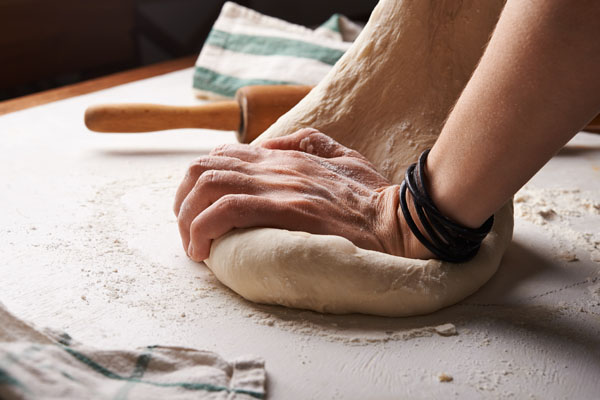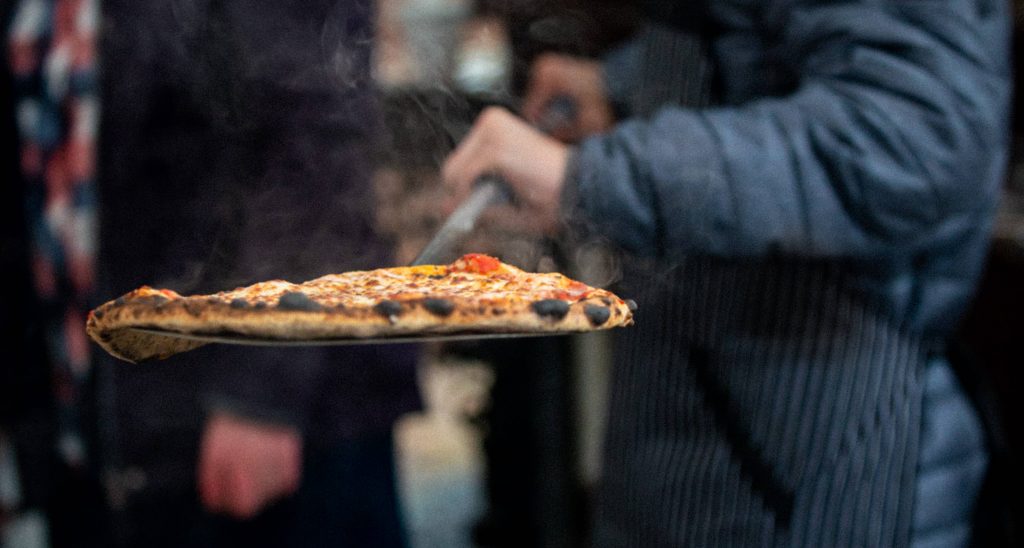Few things are more frustrating than a too-sticky pizza dough. Your fingers get all messy when you’re kneading it. It gets stuck to the raising box, stuck to your countertop, and the
The most common reasons for sticky pizza dough are:
- Too high hydration
- Too much oil
- Too little kneading.
To fix a sticky pizza dough, you can slowly add flour while kneading the dough. It’s important to add it slowly because both the added flour and additional kneading will make the dough less sticky. If you’re not careful, adding too much flour you might end up with a dough that’s too dry and dense. The ideal pizza dough should be a little sticky, but not so sticky that it gets stuck to the working surface.
What Makes Pizza Dough Sticky?
Making perfect pizza dough is hard. There are so many factors that affect the consistency of the dough, such as hydration, the type you use, and how much you’re kneading the dough.
Too Much Water
The most common reason your pizza dough is sticky is that it has too high hydration, meaning it contains too much water.
Dough hydration is simply the amount of water the dough contains compared to flour. You express to hydration as percentages. E.g. 70% hydration. That means that the amount of water the dough contains is 70% of the amount of flour. Therefore, a 70% hydrated dough may have 1000g of flour and 700g of water.
Generally speaking, the higher the hydration, the stickier the dough is. In other words, the more water you add to the dough, the more sticky the dough is going to be. There are also other factor that play into how sticky the dough turns out, such as how much water the flour is able to absorb.
If you’re looking for a non-sticky dough, I recommend hydration of around 65%. If you go any higher, the dough will start to get stickier. You always play with the hydration and try to increase it if you like softer, lighter doughs.
I’ve created an easy pizza dough calculator if you want to play around with different hydration.
The Wrong Flour – Too Much Water Absorption
I’ve noticed that most pizza dough recipes don’t specify the type of flour you should use. You may therefore run into trouble if you’re using the wrong type of flour and hydration combination.
Water Absorption
Not all types of flour are equal. Not even all Italian tipo 00 flours are equal. How much water the flour you’re using can absorb will hugely change the pizza dough.
A stronger flour, with a high gluten content, is usually able to absorb more water. Therefore a stronger flour is going to be a better choice for a higher hydration pizza dough.
Flours strength is measured in “W”, but unfortunately it’s rarely on the package of the flour. It therefore can be a bit tricky to find. I’ve created a table here, that shows the strength of different types of flour and recommended hydration. But most Italian 00 pizza flours have a strength of 200-300W, which should work great for 60-75% hydration.
Humidity
If you live in a humid environment the moisture from the air will be absorbed. This means that the same dough made in a dry vs. humid environment will end up with different will end up with different hydration. The hydration may vary by several percentage points. In a humid environment, the dough will absorb more moisture, effectively increasing the hydration. This can lead to a more sticky dough than you intended.
Gluten Development
A common mistake a lot of people do is to not knead their pizza dough enough. That will most likely leave you with sticky pizza dough! Gluten is formed when you knead the pizza dough. Kneading takes longer than you think. If you’re kneading by hand, it can take anywhere from 15-30 minutes. When you keep kneading the dough you will notice that the stickiness is reduced over time. I’ve also written an in-depth article about how to master gluten in pizza dough if you want to know more.
For proper gluten development, it’s also important to have flour with high enough gluten (protein) content. I love Caputo’s pizza flours and have had great success with them. Caputo is a Naples-based company that mills pizza flour for local restaurants as well as pizzerias around the world. And they are well known for their quality flour. The article Caputo 00 Flour: Everything You Need to Know will get you started if you’re not familiar with Italian pizza flour.
Stickiness is only one of the problems lack of gluten development can lead to. The dough will end up compact, and rip wen you try to stretch. Bottom line – get proper flour, get your hand dirty, and work that dough!

What Do to If Your Dough Is Too Sticky?
Okay, you’re standing there with a dough that’s too sticky… what should you do? How do you make pizza dough less sticky? Don’t panic! We can fix this!
Start by kneading the dough properly, to make sure the gluten is properly developed. If this isn’t enough, slowly add flour while keep kneading. But be careful not adding too much flour, since that can make your dough too dry and dense.
Do You Always Want Less Sticky Pizza Dough?
Even though sticky pizza dough may feel extremely annoying, sometimes you actually want a sticky pizza dough. Not necessarily because you want the dough to be sticky, but certain types of dough characteristics are only present in sticky dough.
High Hydration
High hydration is one of the things that makes the dough more sticky, however, you may want to increase the hydration to achieve a different crust consistency. To get a crispy, light crust, you might want to increase the hydration to 65-70%. And this will make the dough sticky to work with. The result is however a much lighter crust with larger bubbles.
How Do You Keep Pizza Dough From Sticking?
Sticky pizza dough complicates the whole pizza baking process. Here’s how you deal with sticking in each step of the process.
Kneading
Kneading a sticky dough can be really challenging because it will both stick to the working surface and your hands. I therefore strongly recommend using a dough scraper. This will make handling the dough a lot easier. I have an article on pizza dough scrapers if you want to know how to properly use one.
Another thing you can do is apply some water to your hands. Especially in the early stages of kneading the dough will get stuck yo your fingers, and adding water will help. You can also use oil, but since I often make Neapolitan-style pizza dough that doesn’t contain oil, I try to avoid that.
Rising
After kneading your dough should be a little less sticky. If it still is sticky, you can apply a little bit of oil to the dough before placing it in a bowl for rising.
My personal experience is that for most dough, rarely need to apply any oil, to get it out of the container. It’s usually pretty easy to use a dough scraper. All you need to do is hold the bowl upside-down and gently release the dough from the bowl. Gravity should take care of the rest.
The same applies if you’re having a second leave in dough balls. You don’t really need any oil to prevent the dough balls from sticking, but you can apply a little bit if you’re struggling to get them out. Another thing you can do is to drizzle some flour over them before taking them out. Then simply slide the dough scraper under the dough ball and lift it straight up.
Stretching the Dough and Topping the Pizza
When you’re ready to shape your pizza, start by tipping it in flour, then shake off any flour that doesn’t stick to the dough. This will create a thin flour layer on the entire surface of the dough, leaving it with no sticky spots.
Next, you can stretch out the dough, and top it. I recommend doing this on the kitchen counter, to avoid leaving the dough for too long on the
Pizza Peel
To prevent sticking to your
Semolina can also handle higher heat than finer ground tipo 00 flour. Wheat flour can burn in the oven if you’re baking pizza in a
Another popular choice for dusting is cornmeal, but I’m not a huge fan of the flavor it adds to the crust. Cornmeal also doesn’t handle heat as well as semolina and therefore burns in the oven.
Using the right kind of

Prevent Sticking to Pizza Stone
If you’re baking pizza on a hot baking surface, such as a pizza stone or steel, the dough will not stick to the baking surface. The reason is that the heat will vaporize the moisture in the dough, making it crispy. When there is no water, the dough will not stick to the baking surface anymore. You therefore don’t need to dust your pizza stone or do anything else to prevent sticking. If you want to read more, check out my easy guide to using a pizza stone.
- Is Your Pizza Dough Too Dry? Here is How to fix it! - June 10, 2024
- The Ultimate Guide to the Pizza Dough Windowpane Test - June 8, 2024
- The Ultimate Guide to Autolyse Pizza Dough - June 7, 2024

I would like some help with my dough proofing. Its seems to over proof within 24 hours
I let is rise for two hours
Fridge it take it out the next evening
For pizzas snd within 3 hours after frigeing it. It becomes sticky and deflates. Maybe i am using two much yeast?
It sounds like an over-proofing issue. So reducing the amount if yeast will probably help!